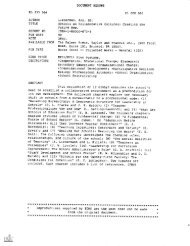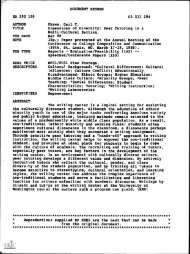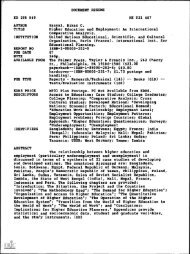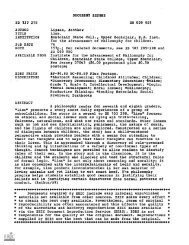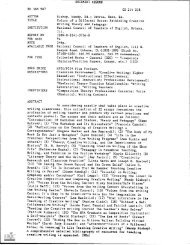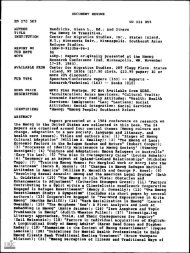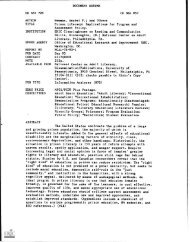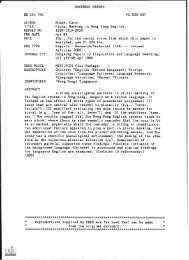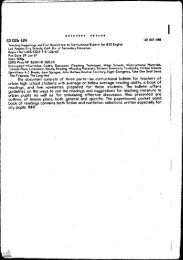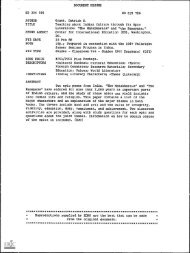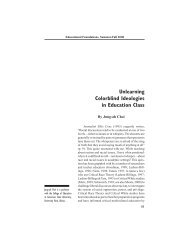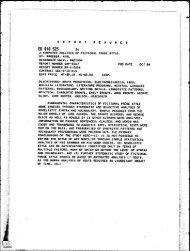Westside Test Anxiety Scale Validation - Eric
Westside Test Anxiety Scale Validation - Eric
Westside Test Anxiety Scale Validation - Eric
Create successful ePaper yourself
Turn your PDF publications into a flip-book with our unique Google optimized e-Paper software.
<strong>Westside</strong> <strong>Test</strong> <strong>Anxiety</strong> <strong>Scale</strong> <strong>Validation</strong>byRichard Driscoll, Ph.D.American <strong>Test</strong> <strong>Anxiety</strong> AssociationAbstractThe <strong>Westside</strong> <strong>Test</strong> <strong>Anxiety</strong> <strong>Scale</strong> is a brief, ten item instrument designed toidentify students with anxiety impairments who could benefit from an anxietyreductionintervention. The scale items cover self-assessed anxiety impairmentand cognitions which can impair performance. Correlations between anxietyreductionas measured by the scale and improvements in test performance wereused as the validation criteria. Subjects were from two diverse samples: 25anxious college students, many on academic probation, and 34 anxious fifth gradestudents. Each sample was divided into Intervention and Control groups, withthe Intervention groups receiving an anxiety-reduction training. <strong>Anxiety</strong> scoresand test scores were attained prior to the study and after Interventions. <strong>Anxiety</strong>reduction benefits as measured by the <strong>Westside</strong> scale correlated .49 and .40 withtest gains for the college and fifth grade samples respectively. The average correlationwas r = 44, indicating that changes in the <strong>Westside</strong> scale accounted for20% of changes in these objective tests. The solid validation coefficient combinedwith the replication in two diverse student populations indicate that the <strong>Westside</strong>scale is a reliable and valid measure of test-anxiety impairment. As the scale isbrief and easily administered, is public access and free of charge to schools, andis shown to be a reliable and valid measure, it is recommended that the <strong>Westside</strong><strong>Test</strong> <strong>Anxiety</strong> <strong>Scale</strong> be considered by intervention programs to screen for testanxietyimpairments.IntroductionBetween 15–35 percent of students are adversely affected by high test anxiety,depending on the criteria for inclusion and the students sampled. Highly anxious studentsscore about 12 percentile points below their low-anxiety peers (Hembree, 1988), makingtest anxiety one of the more serious academic handicaps among students today.School programs to reduce test-anxiety impairment need an instrument to identifythose students who are anxious and might benefit from an anxiety-reduction intervention,with some assurance that the instrument properly identifies test-anxiety impairments.1
The <strong>Westside</strong> <strong>Test</strong> <strong>Anxiety</strong> <strong>Scale</strong> is an extremely brief screening instrument meantto identify students with anxiety impairments. The scale is comprised of ten items, andtakes about five to eight minutes to administer. It has been used by school counselorsover several years, and has been the primary anxiety measure in three research projects.The aim of the present investigation is to validate the instrument, so school programscan better understand its properties and have confidence in its applications.MethodContent validityWhile test anxiety is ordinarily considered to include physiological over-arousal,along with cognitions including dread, worry, and expectations of catastrophic failure,schools are most interested in the impairment aspect of the condition. Excessive testanxiety often contributes to impaired test performance, and the term "test anxiety" iscommonly used to refer to the anxiety and its accompanying impairment (Hembree,1988).Worry and dread are thought to interfere with concentration and are closely associatedwith impairment, while over-arousal without the worry features is only looselyassociated with impairment (Deffenbacher, 1980; Cassady and Johnson, 2001). To assesstest-anxiety impairment, therefore, it seems reasonable to include cognitive worry items,but not physiological over-arousal items, and to combine these items with self-assessedperformance impairment items.The <strong>Westside</strong> scale combines six items assessing impairment, four items on worryand dread, and no items on physiological over-arousal. The cognitive items are similar tothose in the Cassady-Johnson (2001) Cognitive <strong>Test</strong> <strong>Anxiety</strong> <strong>Scale</strong> and in other familiaranxiety scales, and the impairment items are similar to those on the Alpert-Haber (1960)Debilitative <strong>Anxiety</strong> <strong>Scale</strong>.The <strong>Westside</strong> scale thus has high face validity, in that it includes the highly relevantcognitive and impairment factors but omits the marginally relevant over-arousal factor.Change scores<strong>Validation</strong> is traditionally accomplished by showing that a test anxiety instrumentidentifies students with lower test performance, or that it correlates with establishedinstruments that are already considered validated. The excellent Cognitive <strong>Test</strong> <strong>Anxiety</strong><strong>Scale</strong> by Cassady and Johnson (2001) attained r = .25+ correlations to course test scores,accounting for a respectable 7–8% of the test variance. Yet fully 25% of the variancecould be accounted for by the scores on a prior course exam, and the scale could notimprove upon the predictive power of that prior exam.2
Use of change scores should provide a significant advantage. We should have moreconfidence in a scale if it could be shown that changes in the test-anxiety scores areclosely related to changes in test performance. As test-anxiety scores decrease, we shouldfind that test performance improves (and vice versa). So far as a test anxiety scale is avalid measure of test impairment, then variations in that scale should move together withvariations in test performance (other factors being equal).The current investigation looks at two anxiety-reduction intervention studies, alreadypublished, and correlates changes in the <strong>Westside</strong> scale scores to changes in objectivetest results. The two studies assigned students to Intervention and Control groups, administeredan Accelerated Desensitization & Adaptive Attitudes Training (Driscoll, 2006) tothe Intervention students, and assessed the results.ResultsA 2004 intervention with anxious college students included 20 students, half onacademic probation, assigned in equal proportion to Intervention and Control groups(Driscoll, Holt, & Hunter, 2005). Students took midterm exams, the Intervention studentsreviewed the ADAA Training an average of twice, and students took finals. The testchange scores were the finals scores minus the midterm scores. <strong>Test</strong> scores improved anaverage of 18 percentile points for the Intervention students over the controls. <strong>Anxiety</strong>change scores were obtained from 11 of the students, and the anxiety-reduction benefitswere substantial.A 2005 replication involved 18 students, all on academic probation. <strong>Test</strong> scores improvedan average of 3 percentile points for Intervention students over Controls. <strong>Anxiety</strong>change scores were obtained from 14 of the students, and the anxiety-reduction benefitswere modest.Given the similarities between the two samples, the results were combined for thepresent analysis. The combined sample included 25 students—16 of whom received theIntervention, and 9 Controls. The correlation between anxiety-reduction on the <strong>Westside</strong>scale and test gains for the combined sample was r = .49 (df = 23, p < .01) indicating astrong correspondence between anxiety-reduction and objective test gains.An Intervention with fifth grade students screened an entire fifth grade class and included36 highly anxious students (Miller et al., 2006). The Intervention group reviewedthe training five times over six months. <strong>Test</strong> change scores were the 2005 state TCAPtest scores adjusted for student 2004 scores, and test scores for the Intervention group improvedan average of 7 percentile points over the Controls. <strong>Anxiety</strong> change scores wereattained from 34 students, and the anxiety levels for the Intervention students declinedmodestly but not significantly so.3
The correlation between anxiety reduction on the <strong>Westside</strong> scale and test gains wasr = .40 (df = 32, p < .01), indicating again a clear correspondence between changes on thescale and objective test gains.<strong>Scale</strong> validity, based on the average of the two attained correlations weighted by thenumber of subjects in each study, is calculated here as r = .44 . Thus, changes in anxietyimpairment as measured by the <strong>Westside</strong> scale accounted for 20% of the changes in testperformance in these samples.DiscussionThe consistent correlations in two separate populations between changes on the <strong>Westside</strong>scale and changes in test performance indicate that the scale is a reliable indicator ofperformance impairment. Similar results were attained with college students, many onacademic probation, and with 5th grade students, most in good standing, suggesting thatthe scale is a reliable measure across quite different population samples.The .44 coefficient of validity is high by current standards. Some of that may be dueto the scale itself, which combines interfering cognitions with experienced impairmentand thereby covers the most pertinent factors and omits the marginal ones. Yet much ofthe higher coefficient should be reasonably attributed to the use of change scores for thevalidation, instead of the usual method of correlating stationary scores. Given significantchanges in anxiety levels and in performance, decreases on a valid measure of anxietyimpairment should correlate to performance gains, as was the case here. Taken together,the research indicates that the <strong>Westside</strong> <strong>Test</strong> <strong>Anxiety</strong> <strong>Scale</strong> is a reliable and valid measureof test-anxiety impairment.As the instrument is brief and easily administered, is public access and free of chargeto schools, and is seen to be a reliable and valid measure, it is recommended that the<strong>Westside</strong> scale be considered by school intervention programs to screen for test-anxietyimpairments.4
Appendix A: <strong>Westside</strong> <strong>Test</strong> <strong>Anxiety</strong> <strong>Scale</strong>Rate how true each of the following is of you, from extremely or always true, to not at allor never true. Use the following 5 point scale.5 4 3 2 1extremely highly or moderately slightly not at allor always usually or sometimes or seldom or nevertrue true true true true__ 1) The closer I am to a major exam, the harder it is for me to concentrate on thematerial.__ 2) When I study, I worry that I will not remember the material on the exam.__ 3) During important exams, I think that I am doing awful or that I may fail.__ 4) I lose focus on important exams, and I cannot remember material that I knewbefore the exam.__ 5) I finally remember the answer to exam questions after the exam is already over.__ 6) I worry so much before a major exam that I am too worn out to do my best on theexam.__ 7) I feel out of sorts or not really myself when I take important exams.__ 8) I find that my mind sometimes wanders when I am taking important exams.__ 9) After an exam, I worry about whether I did well enough.__ 10) I struggle with writing assignments, or avoid them as long as I can. I feel thatwhatever I do will not be good enough._____ Sum of the 10 questions_____ Divide the sum by 10. This is your <strong>Test</strong> <strong>Anxiety</strong> score.What does your test anxiety score mean?1.0—1.9 Comfortably low test anxiety2.0—2.5 Normal or average test anxiety2.5—2.9 High normal test anxiety3.0—3.4 Moderately high (some items rated 4=high)3.5—3.9 High test anxiety (half or more of the items rated 4=high)4.0—5.0 Extremely high anxiety (items rated 4=high and 5=extreme)© 2004 by Richard Driscoll, Ph.D. You have permission to copy this scale for personaluse and for institutional uses (but not for resale).5
ReferencesAlpert, R. & Haber, R.N. (1960). <strong>Anxiety</strong> in academic achievement situations. Journalof Abnormal and Social Psychology, 10, 207–215.Cassady, J. & Johnson, R. (2001). Cognitive test anxiety and academic performance.Contemporary Educational Psychology, 27, 270–295.Deffenbacher, J.L. (1980). Worry and emotionality in test anxiety. In I.G. Sarason (Ed.),<strong>Test</strong> anxiety: Theory, research, and applications (pp. 111–124). Hillsdale, NJ:Erlbaum.Driscoll, R. (2006). STARS–PAC Accelerated <strong>Anxiety</strong> Reduction: Rationale and InitialFindings. ERIC, 18 pp.Driscoll, R., B. Holt, & L. Hunter (2005). Accelerated Desensitization and AdaptiveAttitudes Interventions and <strong>Test</strong> Gains with Academic Probation Students. ERIC,13 pp.Hembree, R. (1988). Correlates, causes, effects and treatment of test anxiety. Review ofEducational Research, 58 (1), 47-77.Miller, Melanie, J. Morton, R. Driscoll & K.A. Davis (2006). Accelerated Desensitizationwith Adaptive Attitudes and <strong>Test</strong> Gains with 5th Graders. ERIC, 14 pp.6



